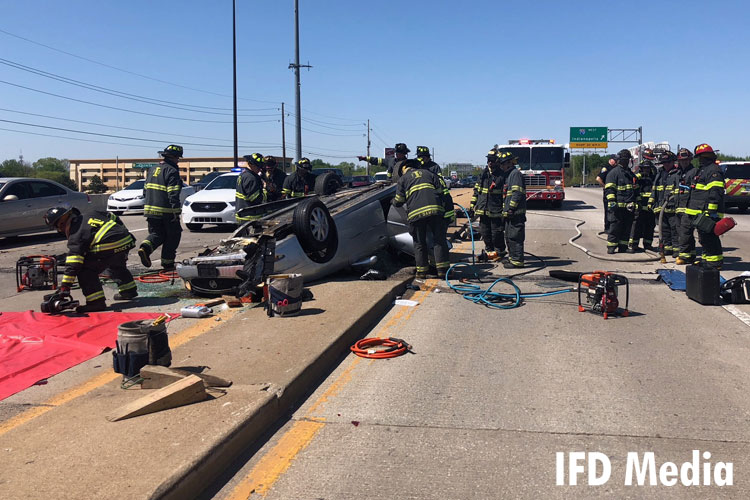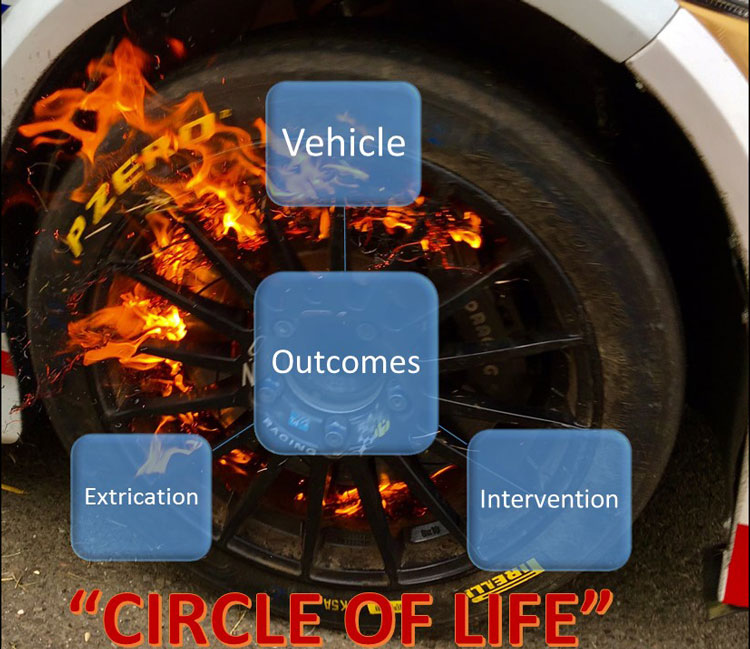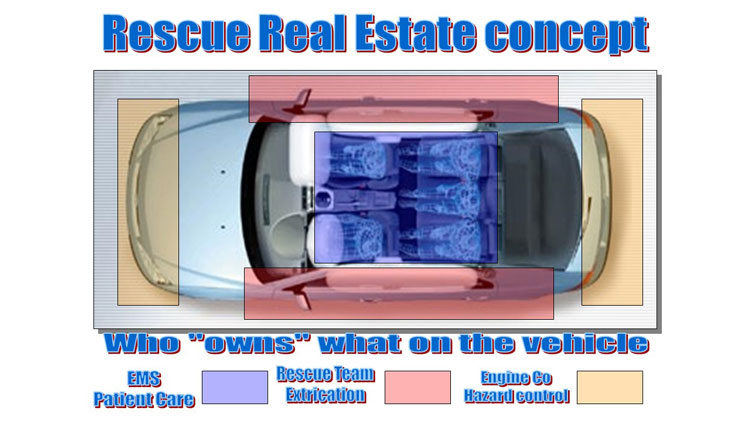

By Dave Dalrymple
Photo courtesy the Indianapolis Fire Department
Many of the ideals and methods firefighters retain about vehicle extrication as a subject matter have been handed down over the past 50 years or so ago. Let’s think about that for a moment. We’ve had automobiles for more than 100 years. But we’ve not had “modern” rescue tools since the 1960s. The 1970s saw the emergence of two important parts of the response equation: power hydraulic rescue tools and EMS. The 1980s saw the emergence of a key point of vehicle extrication, namely training materials. Harvey Grant wrote his first book on vehicle rescue in the early ‘80s, and in the latter part of the decade saw the introduction of the first video-structured training program that had supporting written documentation in the format of instructor guides. This program was called “The Carbusters,” and was authored by Steve Kidd and John Czakowski. Part of the Carbusters series was a video tape by Ron Moore, who was an early pioneer in realm of school bus extrication. The early ‘90s saw books emerge from Ron Moore, a second edition of Vehicle Rescue by Harvey Grant and Jim Gargan. On the training grounds, we had Dwight Clark, OB Streeter, Al Sergio Sr., Don Gardner, Ken Jones. These are just a few of the many that took some of the lessons and added their own life knowledge and skills to the discipline, advancing vehicle extrication so that we might add our own contributions. Vehicle rescue instructors today are truly standing on the shoulders of giants.
The Patient Is the Priority
But are we leaning too much on the lessons of the past? What of “new” ideas, concepts, methodology, techniques have we as the next generation of instructors passed on? To be sure, we have taken tool evolutions and progressed along the evolutionary scale, making evolutions faster, smoother, and safer. We have improved upon them and even created new ones to make old ones work again.
But what about methodology? What about the bigger picture? Well, the two biggest items at a motor vehicle crash are patient care and safety. Safety is always paramount. There are fantastic gear options nowadays, including Hi-Viz vests. We have traffic incident management training, and we protect scenes today with apparatus. We even have on-scene hazard information available via smartphone or tablet apps. At every training class we attend, patient care is mentioned. Yet in the practical skill sessions, how often do we see some sort of “patient representation” in our training vehicles? Some train this way, but many do not.
RELATED: PATIENT CARE AT MOTOR VEHICLE ACCIDENTS | PATIENT AND RESCUE CONSIDERATIONS | Rescue Real Estate: Simultaneous Operations at a MVC
How are we to expect our students to interact with a patient on a variety of levels when there isn’t one present in training? This leads us to perform “junkyard” tool evolutions like a 42-inch dash lift with the tool sitting where the driver’s legs would be. Why is patient management so important, you might ask? Some might say we have an ambulance who does EMS out of the station, or another agency provides it to us. It is so valuable to that patient that you can see visual clues from the wrecked vehicle, both outside and inside. Rescuers may give a fast patient assessment to evaluate what type of a patient they are dealing with, and to determine if they have time to do a proper extrication. We may do such an assessment 95 percent of the time, but what about the rest of the time? That’s when things get hot and you’ve got to hustle and make a big hole NOW!
If you don’t have those patient management skills, you might have a situation that involves rapid status changes in the car. Have you ever seen an incident where there is a dynamic shift or change that no one expects? There are usually negative consequences, and sometimes the patient expires in the vehicle. To return to our previous point, If the EMS providers arrive at the same time as you or before you, that’s great. But how many times do you arrive first on scene, or there are multiple patients to be managed? Firefighters do not need to be doctors or even paramedics, but they must have the fundamental ability to read visual clues and determine who is sick and who is not.

A point on terminology. Let’s use phrases that describe the full “circle of life” in our workspace, the vehicles. People enter the vehicle as “occupants.” When they have crashed, they become “casualties.” When we intervene and start care, they are “patients.” Finally, when all is said and done, they become “survivors” or “fatalities,” depending on the outcome. While we are speaking about vehicle extrication, all forms of rescue ARE patient care driven! Why else would we be there? What other metric of success should we as rescuers use? Along with that, after ensuring we go home safely, our aim must be to provide for a better patient outcome. Extrication is a medical intervention. Trauma is the disease of time.
Put those two declarations together and you get a powerful message that dovetails nicely with our priority: Making sure of a better patient outcome. Once again:
- Extrication is a medical intervention
- Trauma is the disease of time
- Strive to ensure a better patient outcome
Although spacemaking is a technical (mechanical) skill, its roots are firmly based in our patient outcome. Rescue is a patient-care driven skill.

To convert this mindset into a practical skill set along with spacemaking, we developed the concept of “Rescue Real Estate.” A group of instructors came up with this idea when we were trying to come up with a way to coordinate operations so that everyone who arrives on scene can work and not be in each other’s way. This idea developed into a concept over time and through trial and error at classes. It comes down to who does what job or role they play AND where that is in or on the vehicle. First off, hazard control, including power isolation, is handled usually by the engine. Since 97 percent of vehicles the 12V battery is either in the front or rear of the vehicle they “own” those areas. Second, since we have a patient involved in this motor vehicle crash and we need to begin patient management, EMS needs to access the interior of the vehicle, so EMS “owns” that space. Finally, our rescue team “owns” the exterior of the vehicle specifically, the sides between the front and rear wheels. If you think about it, pretty much all your tool evolutions are performed in that area on the vehicle. Try implementing this concept, and you will likely find it works surprisingly well.
Part 2: The Mindset and The Technique
DAVID DALRYMPLE, AIETecRI, is a firefighter/EMT/rescue technician for Clinton (NJ) EMS/Rescue. He has been actively involved with emergency services for 34 years, having taught transportation rescue topics for more than 22 years. He is the executive educator for RoadwayRescue LLC, a dynamic educational team for transportation rescue training. He has taught at FDIC since 2003, and was team captain when Clinton’s team won the world vehicle rescue challenge in 1998. He is certified as an International level extrication assessor and has taught and assessed in North America, Europe, the UK, and South Africa. In 2007, he received the coveted Harvey Grant award for excellence in rescue education. Dave is also a member of the Society of Automotive Engineers (SAE) task force on hybrids and electric vehicles for first and second responders. He volunteers as a fire/rescue technician for the Sports Car Club of America-Northern New Jersey region and is actively involved in emergency response at performance rally events with American Rally Association. He is a member of the International Council on Motorsport Science and his ESRS rally rescue program holds SFI accreditation. Besides writing for fire rescue publications, he is a contributing author for the PennWell Firefighter I & II textbook and is featured in a three-DVD educational series on vehicle rescue from PennWell/Fire Engineering. He is also the host of three seasons of extrication Training Minutes videos.
MORE
Fender Unlock: A New Extrication Concept Using Current Tool Evolutions

